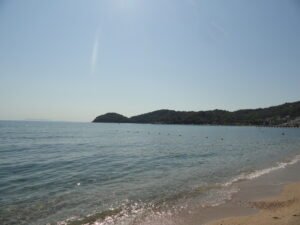 The ruins of the ancient city of Stageira (also spelled Stagira) can be found on two hills on a promontory on the east coast of the Chalkidiki region of northern Greece, about 70 km east of the city of Thessaloniki.
The ruins of the ancient city of Stageira (also spelled Stagira) can be found on two hills on a promontory on the east coast of the Chalkidiki region of northern Greece, about 70 km east of the city of Thessaloniki.
Stageira was founded in the middle of the seventh century BCE and spent the next few centuries caught up in the shifting political winds of the region. The city’s main claim to fame is as the birthplace of Aristotle; the great philosopher was born there in 384 BCE. His parents died when he was young, so he was mostly raised by a relative in Atarneus in Asia Minor before moving to Athens at age 17 or 18 to study at Plato’s Academy. However, it seems that he maintained a soft spot for his hometown: when later in life he returned to the north at the invitation of the Macedonian King Philip II to tutor his son, the future King Alexander the Great, he managed to convince Philip to rebuild Stageira, which Philip had destroyed when he took the city in 348 BCE. But it seems the city never recovered, and the ancient geographer Strabo, who lived around the time of Christ, reported it as already abandoned in his day.
Some of the city’s walls are still in good shape, especially the land wall on the southwestern side of the city. There was a fortress at the highest point on this wall, at the top of the city’s south hill, which has some nice views of the surrounding area.
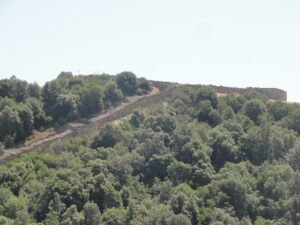
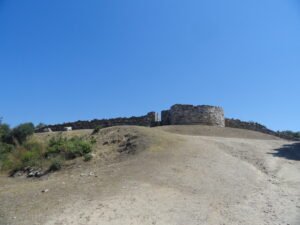
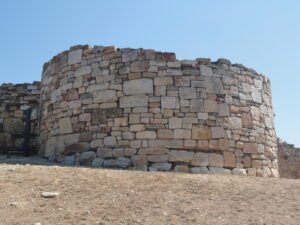
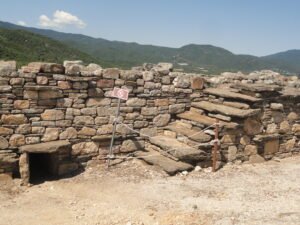
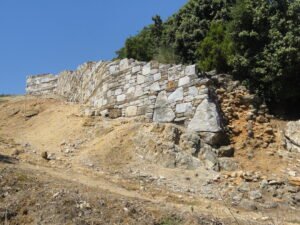
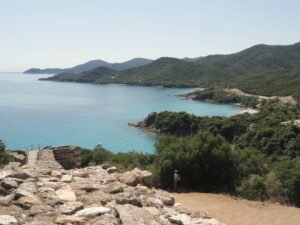
At the top of the north hill — the one further out on the promontory — are the ruins of a Byzantine fortress (built here after the abandonment of the city), and inside the fortification wall is what is left of an Archaic temple.
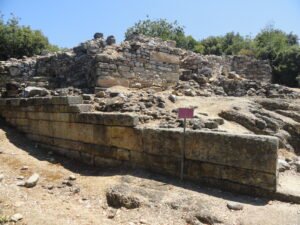
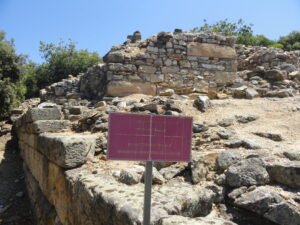
In between the two hills was the agora, which was the city’s marketplace and the center of social life in the city. There was a large stoa here, built in Classical times, and in front of it are a couple of excavation pits with some traces of older buildings from the Archaic period. Not far from the stoa, there is also a small rectangular structure which was once a water cistern.
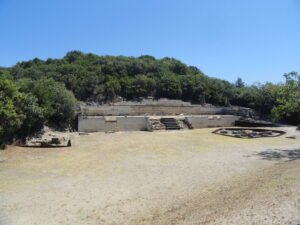
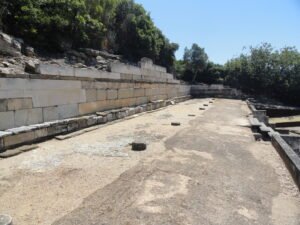
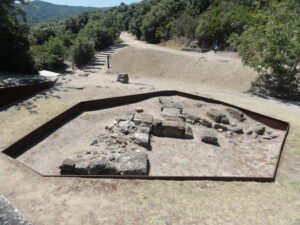
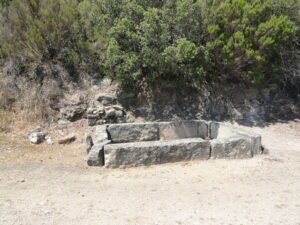
Next to the stoa are shops and storerooms, also from the Classical period.
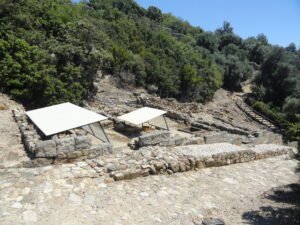
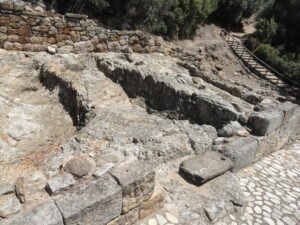
There are more Archaic buildings at the edge of the promontory at the northeastern end of the city, including a seaside sanctuary.
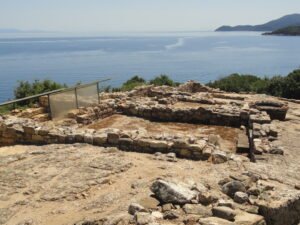
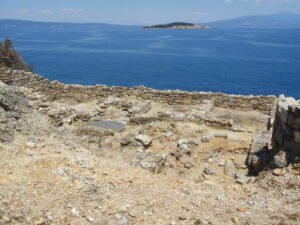
The ruins of several ancient houses can be found in various places around the site. Some of the most impressive ruins of houses are on the southern slope of the north hill.
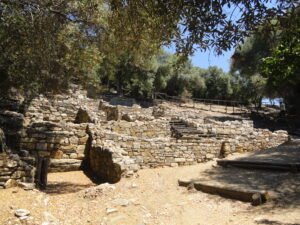
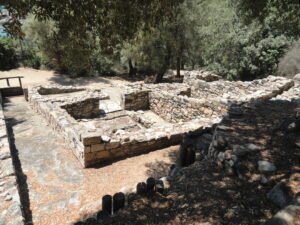
One of the most interesting structures at the site is the so-called “Apsidal Building,” a Hellenistic structure located on the southwestern slope of the north hill not far from the agora which was originally identified as a probable heroon, or grave/monument of a hero. In recent years, some have speculated that this could be the tomb of Aristotle. This is based on a tradition recounted in a medieval Arabic manuscript (now called the Vita Aristotelis Marciana, as it sits in the Marciana Library in Venice) which claims that when Aristotle died in Chalcis in 322 BCE, his remains were brought back to Stageira and an elaborate funeral was held for him. The document goes on to say that an altar was set up over his grave, and the place (called the Aristoteleion) served as the assembly point for the city’s council. If this account is true, the Apsidal Building is the best candidate found so far for the Aristoteleion, but this is far from proven.
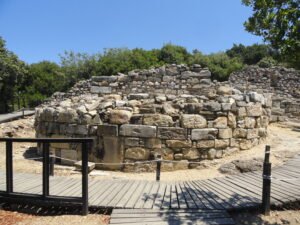
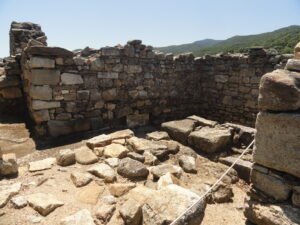
Tips for the Visitor
To get to Stageira, you need to make your way to the village of Olympeiada. Do not be confused by the fact that there is a modern village called Stageira, even though there is an Aristotle-themed park there, and unfortunately many tourists have made this mistake. Modern Stageira is a 25-km drive from ancient Stageira, and there are no public transportation options connecting them, so if you go to the wrong Stageira, you might not be able to correct your mistake.
 There are infrequent buses to Olympeiada from the main KTEL bus terminal in Thessaloniki, sometimes just one in the morning and one in the afternoon each way. Although there is a separate terminal in Thessaloniki for buses headed for the Chalkidiki region, and Olympeiada is in that region, buses to Olympeiada are an exception and depart from the main terminal instead. The journey takes nearly two hours, and you will probably be asked to change buses for the last leg of the trip either in or near the town of Stavros as the bus you start out with will continue north to Asprovolta (which is probably the reason why the bus doesn’t leave from the Chalkidiki terminal), but the bus staff will guide you on which bus to change over to. Unless you plan on staying the night, be sure to check in advance what time you will be able to get the bus back to Thessaloniki from Olympeiada, as there will most likely be only one or two options.
There are infrequent buses to Olympeiada from the main KTEL bus terminal in Thessaloniki, sometimes just one in the morning and one in the afternoon each way. Although there is a separate terminal in Thessaloniki for buses headed for the Chalkidiki region, and Olympeiada is in that region, buses to Olympeiada are an exception and depart from the main terminal instead. The journey takes nearly two hours, and you will probably be asked to change buses for the last leg of the trip either in or near the town of Stavros as the bus you start out with will continue north to Asprovolta (which is probably the reason why the bus doesn’t leave from the Chalkidiki terminal), but the bus staff will guide you on which bus to change over to. Unless you plan on staying the night, be sure to check in advance what time you will be able to get the bus back to Thessaloniki from Olympeiada, as there will most likely be only one or two options.
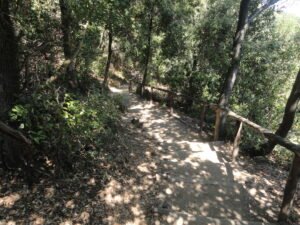 You can enter the archaeological park from two different entrance/exit points, and these are clearly signposted as you make your way east by foot or by car from the eastern end of the village of Olympeiada. The site was free at the time of our visit but closed at 15:30 on the days it was open, which was every day except Tuesday. Be sure to check the opening hours before you visit.
You can enter the archaeological park from two different entrance/exit points, and these are clearly signposted as you make your way east by foot or by car from the eastern end of the village of Olympeiada. The site was free at the time of our visit but closed at 15:30 on the days it was open, which was every day except Tuesday. Be sure to check the opening hours before you visit.
There is a main trail to follow during your visit, which is shown with a red line on the map displayed on every signboard throughout the site. There are also additional trails marked on those maps in green which are offered for those who want to see more of the site, but these were off-limits at the time of our visit, although not all of them had signs marking them as off-limits.
Location Map
